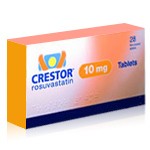When Fats Go Rogue: Understanding and Treating High Blood Lipids


Abnormally high levels of lipids in the blood — often referred to as hyperlipidemia or dyslipidemia — are among the most important and modifiable risk factors for cardiovascular disease. Over many years of biochemical, genetic, and clinical research, we have come to recognize not only the definitions and mechanisms behind these lipid disturbances, but also how they manifest (or often don’t), and how modern therapies such as Crestor (rosuvastatin) can help manage them.
What Are Abnormally Elevated Lipids?
Lipids are a class of molecules that includes cholesterol, triglycerides, phospholipids, and fatty acids. Because they are not water-soluble, lipids are transported through the bloodstream inside structures called lipoproteins — such as LDL (low-density lipoprotein), HDL (high-density lipoprotein), and VLDL (very low-density lipoprotein).
When the levels of these lipids — or the lipoproteins carrying them — exceed what is considered physiologically safe, we refer to the condition as hyperlipidemia or dyslipidemia. This means that the blood contains too much cholesterol, triglycerides, or both.
In clinical practice, “high cholesterol” usually refers to elevated LDL, which is the form most strongly associated with the development of atherosclerosis — a process in which fatty plaques accumulate on artery walls, leading to heart attacks and strokes.
While the exact thresholds may vary depending on individual risk factors and guidelines used, LDL cholesterol levels over 160–190 mg/dL and triglycerides above 200–500 mg/dL are generally considered abnormally high. Elevated lipids increase the risk of vascular inflammation, plaque formation, and ultimately, cardiovascular events.
What Causes Elevated Blood Lipids?
The causes of abnormal blood lipids fall into two major categories: genetic (primary) and acquired (secondary).
Genetic Factors
Inherited disorders can significantly disrupt lipid metabolism. In conditions such as familial hypercholesterolemia, mutations impair the body’s ability to remove LDL cholesterol from the blood, often resulting in very high levels from a young age. Individuals with these conditions are at increased risk for early heart disease and often require aggressive treatment.
Other hereditary lipid disorders include familial combined hyperlipidemia, dysbetalipoproteinemia, and familial hypertriglyceridemia. These syndromes are less common but may present with severe lipid abnormalities and visible signs like tendon xanthomas or corneal arcus.
Acquired Factors
In most people, elevated lipid levels are caused by a combination of lifestyle factors and other health conditions. Poor diet — especially one high in saturated fats, trans fats, and refined carbohydrates — can raise LDL cholesterol and triglycerides. Sedentary behavior, obesity, and excessive alcohol intake also contribute.
Medical conditions that frequently cause or worsen hyperlipidemia include:
- Type 2 diabetes
- Hypothyroidism
- Chronic kidney disease
- Liver disease
- Nephrotic syndrome
Certain medications can also elevate lipid levels. These include corticosteroids, some beta-blockers, oral contraceptives, and antipsychotics. Additionally, advancing age, smoking, and hormonal changes (such as those during menopause) can play a role in disrupting normal lipid regulation.
In many patients, hyperlipidemia results from a combination of genetic predisposition and secondary influences like poor diet, inactivity, and insulin resistance.
Symptoms of Lipid Disorders
One of the most dangerous aspects of hyperlipidemia is that it is usually asymptomatic. Most people feel completely fine, even as lipid levels climb to harmful levels. Because of this silent progression, routine blood testing is often the only way to detect abnormal lipid levels before complications occur.
When symptoms do occur, they are typically the result of long-term consequences. These include:
- Chest pain or angina from coronary artery disease
- Shortness of breath due to reduced heart function
- Leg pain during walking caused by peripheral arterial disease
- Mini-strokes or strokes resulting from carotid artery plaque
In rare cases — especially with extremely high cholesterol or triglyceride levels — more direct signs may appear. These include:
- Xanthomas: fatty deposits under the skin or tendons
- Xanthelasmas: yellowish plaques on the eyelids
- Lipemia retinalis: a creamy appearance of retinal blood vessels
- Pancreatitis: a medical emergency that can result from very high triglyceride levels (typically above 1,000 mg/dL)
However, most people with elevated lipids have no physical signs, reinforcing the importance of routine screening, particularly in adults over 40 or those with other cardiovascular risk factors.
Is Hyperlipidemia the Same as High Cholesterol?
The terms “hyperlipidemia” and “high cholesterol” are often used interchangeably, but they are not identical.
Hyperlipidemia is a broader term that refers to elevated levels of any lipids in the blood — including cholesterol, triglycerides, or both. It encompasses various disorders affecting different types of lipoproteins.
High cholesterol, more specifically, usually refers to elevated LDL (low-density lipoprotein) cholesterol. This is the “bad cholesterol” most closely linked to plaque buildup in arteries.
So while all cases of high cholesterol fall under the umbrella of hyperlipidemia, not all hyperlipidemia involves cholesterol. Some people have elevated triglycerides but normal LDL, or mixed dyslipidemia with both problems. The distinction is important when tailoring treatment strategies.
The Role of Crestor in Treatment
When lifestyle changes alone do not adequately control lipid levels — or when cardiovascular risk is already high — medication is often needed. One of the most effective and widely used medications for this purpose is Crestor, the brand name for rosuvastatin.
What Is Rosuvastatin?
Rosuvastatin is part of the statin class of medications. Statins work by inhibiting the enzyme HMG-CoA reductase, which is essential for the liver’s production of cholesterol. By blocking this pathway, rosuvastatin helps the liver clear more LDL cholesterol from the blood.
Rosuvastatin is considered a high-intensity statin, meaning it can reduce LDL cholesterol by more than 50% at standard doses. It also modestly increases HDL (the “good” cholesterol) and lowers triglycerides.
Compared to other statins, rosuvastatin has a longer half-life, making it effective even at lower doses in some individuals. It is also less likely to interact with other medications due to its unique metabolic pathway.
Effectiveness and Safety
Clinical trials and real-world studies have shown that Crestor:
- Significantly lowers LDL cholesterol
- Improves HDL cholesterol and triglyceride levels
- Reduces the risk of heart attack, stroke, and revascularization procedures
Crestor has been proven effective not just in people with known cardiovascular disease, but also in primary prevention — helping people with risk factors avoid their first heart attack or stroke.
As with any medication, side effects are possible. The most common are:
- Muscle aches or weakness
- Headache
- Nausea
- Slight increases in liver enzymes
In rare cases, serious muscle damage (rhabdomyolysis) can occur, particularly at higher doses or in people with kidney disease. There is also a slight increase in the risk of developing type 2 diabetes, especially in those already predisposed.
Routine monitoring of cholesterol levels, liver function, and any muscle symptoms is advised during treatment.
Dosing and Special Considerations
Crestor is typically prescribed at doses of 5–40 mg once daily, depending on the patient’s risk level and lipid profile. In people with moderate kidney impairment or certain ethnic backgrounds (such as Asians), lower doses may be recommended due to increased sensitivity.
For patients who do not reach their target LDL levels with statins alone, additional medications such as ezetimibe or PCSK9 inhibitors may be added.
Overall, Crestor is one of the most powerful tools available in the fight against cardiovascular disease due to its lipid-lowering ability and strong outcome data.
Conclusion
Elevated lipid levels in the blood represent a silent yet powerful threat to cardiovascular health. Often symptomless for years, they can lead to serious consequences such as heart attacks, strokes, and vascular disease if left unchecked.
While genetic factors play a role in some cases, most people with hyperlipidemia develop it due to modifiable lifestyle factors and underlying health conditions. Fortunately, effective treatments are available. Lifestyle changes remain the foundation of care, but medications like Crestor offer potent, well-tolerated options for lowering LDL cholesterol and reducing long-term risk.
Regular screening, early intervention, and personalized treatment plans are key. By understanding the hidden danger of high blood lipids—and taking appropriate steps to manage them—we can dramatically reduce the burden of cardiovascular disease in individuals and populations alike.
Drug Description Sources: U.S. National Library of Medicine, Drugs.com, WebMD, Mayo Clinic, RxList.
Reviewed and Referenced By:
Dr. Alan Carter, PharmD Clinical pharmacist specializing in cardiovascular risk management and lipid-lowering therapies. Frequently cited on Drugs.com for reviewing therapeutic guidance on statins, including rosuvastatin’s efficacy, dosing, and safety profile.
Dr. Carol DerSarkissian, MD Board-certified in internal medicine, contributor to WebMD. Her clinical reviews focus on the prevention of cardiovascular disease and the medical management of lipid disorders, including lifestyle and pharmacological interventions.
Dr. Dianne B. McKay, MD Professor of Clinical Pharmacology, contributor to RxList and NIH. Offers expert insights into the renal and hepatic implications of long-term statin therapy, including special dosing considerations in patients with kidney disease.
Dr. William C. Shiel Jr., MD, FACP, FACR Chief Editor at MedicineNet, affiliated with WebMD. Authored extensive educational materials on hyperlipidemia, familial lipid disorders, and the mechanisms and effects of HMG-CoA reductase inhibitors like rosuvastatin.
(Updated at Sep 30 / 2025)

